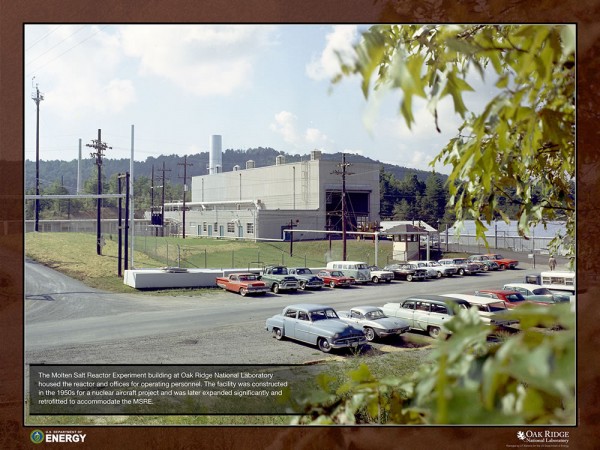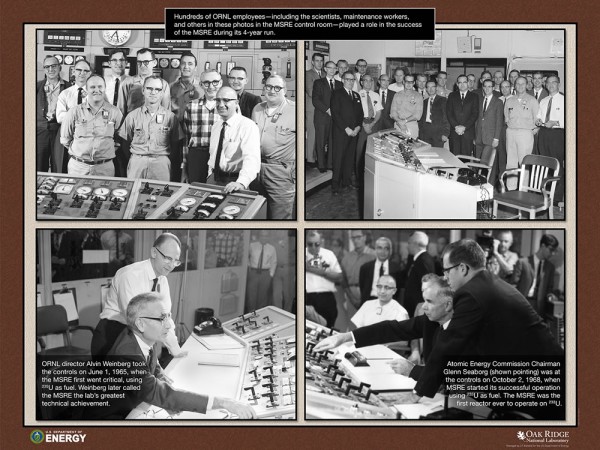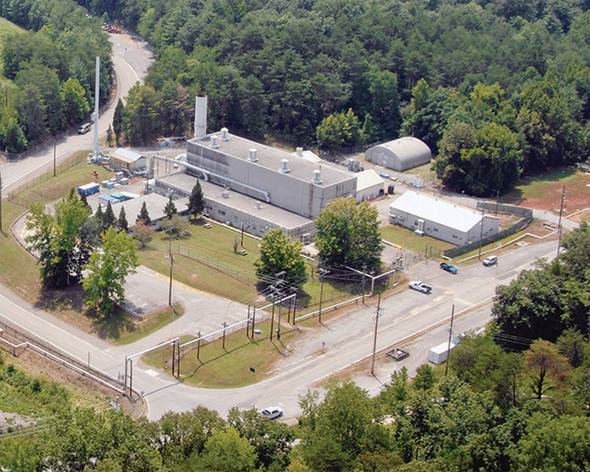
The Molten Salt Reactor Experiment building at Oak Ridge National Laboratory housed the reactor and offices for operating personnel. The facility was constructed in the 1950s for a nuclear aircraft project and was later expanded significantly and retrofitted to accommodate the MSRE. (Photo courtesy U.S. Department of Energy/Oak Ridge National Laboratory)
Cleanup crews started a $4.7 million project this month to reduce maintenance and operations costs at the Molten Salt Reactor Experiment, which was shut down 50 years ago at Oak Ridge National Laboratory.
The project is expected to save nearly $25 million in costs, the U.S. Department of Energy Office of Environmental Management said in an “EM Update” published Tuesday.
The cost-reduction project will relocate employees stationed at the decades-old facility. Personnel currently housed in the building will move to other site locations to help with other projects, the “EM Update” said.
The project is expected to enhance the facility’s electrical distribution, sump pump, fire suppression, and monitoring systems.
“Although it was shut down 50 years ago, certain systems within the reactor building have continued to operate to keep the facility safe and stable until it can be demolished,” said the “EM Update,” with the Oak Ridge story contributed by Mike Butler.
The DOE Oak Ridge Office of Environmental Management, or EM, is responsible for the facility’s safety until decommissioning begins. That’s scheduled to start in the 2030s.
EM de-fueled the reactor by removing uranium from its fuel salts in 2007. The cleanup program is working to identify the best approach to address remaining fuel salts in the building.
“We are improving the reliability of systems that perform safety functions in the facility, which will result in a reduction of operations and maintenance costs that EM can direct to other important deactivation activities across ORNL,†ORNL Portfolio Federal Project Director Bill McMillan said in the update. “The project will also relocate approximately 30 employees currently housed at MSRE, allowing them to assist other projects.â€
Crews will replace existing electrical systems with a new conduit-based electrical system to power essential systems. This change will minimize maintenance costs, reduce risk of injury to workers, and provide reliable electrical service, the “EM Update” said.
The new sump pump system, which removes groundwater from the building’s basement and foundation, will provide more reliable operations, improve safety, and reduce risks during maintenance activities, DOE said.
Workers will design and install the new dry fire suppression system, which will eliminate costs associated with purchasing and providing steam from the laboratory.
EM and its cleanup contractor UCOR are scheduled to complete the project in April 2020.
The Molten Salt Reactor Experiment operated for only four years in the 1960s, but it earned an enduring legacy as an innovative technology concept, the “EM Update” said.
Former ORNL Director Alvin Weinberg once called the Molten Salt Reactor Experiment the greatest technical achievement at the lab. It was inspired by the campaign to build a nuclear-powered aircraft in the 1950s, and it was the first reactor to ever operate using uranium-233.
Oak Ridge Today reported in November 2017 that DOE was, at the time, studying whether to entomb parts of the Molten Salt Reactor Experiment. Those parts were reported to be too radioactively “hot†for humans. The current status of the entombment proposal wasn’t immediately clear Tuesday evening.
In 2017, Jay Mullis, manager of the Oak Ridge Office of Environmental Management, said most of the fuel at the Molten Salt Reactor Experiment, a unique reactor that operated from June 1965 to December 1969, was removed about 10 years ago. That included uranium, plutonium, and some uranium-233.
Oak Ridge Today reported at that time that some residual fuel and fission products remained, including cesium and strontium.
The Oak Ridge Office of Environmental Management has previously estimated the cost of removing the salt from the Molten Salt Reactor Experiment and disposing of it at the Waste Isolation Pilot Plant in New Mexico at between $150 million to $200 million. It’s not clear if that estimate has changed.
In the meantime, several million dollars has been spent each year on surveillance and maintenance at the Molten Salt Reactor Experiment and liquid and gaseous waste operations at ORNL, including at what are known as “hot cells,†and costs were expected to increase. Federal officials had asked for $12 million for those surveillance and maintenance operations in fiscal year 2019, the current fiscal year. Oak Ridge Today did not immediately have information on Tuesday about what amount was actually appropriated.
In 2017, Mullis said the Molten Salt Reactor Experiment, which had a control room and reactor room, is degrading.
Construction of the MSRE began in 1962. ORNL has reported that it was the “brainchild†of Weinberg, who was lab director from 1955 to 1973.
The Molten Salt Reactor Experiment went critical on June 1, 1965, with Weinberg at the controls. It started its successful operation using uranium-233 as fuel on October 2, 1968. The MSRE also experimented with plutonium in the fuel salt. It logged more than 13,000 hours at full power during its brief four-year run.
Fully loaded, the MSRE used 11,260 pounds of a fuel salt mixture comprised of lithium, beryllium, zirconium, and uranium fluoride. The fuel salt had a melting point of 840 degrees Fahrenheit.
The coolant salt contained 15,300 pounds of lithium and beryllium fluorides.
The MSRE lost funding and the entire program was shut down in 1973.
The reactor has been dormant ever since.
The MSRE was designated as a nuclear historic landmark in 1994, according to ORNL.
There has continued to be interest in molten salt reactors.
See ORNL posters commemorating the 50th anniversary of the start of the MSRE here. See an ORNL story on the 50th anniversary from 2015 here.
See previous story here.
See another story on the MSREÂ here.
More information will be added as it becomes available.

Captions: Top—Hundreds of ORNL employees—including the scientists, maintenance workers, and others in these photos in the MSRE control room—played a role in the success of the MSRE during its four-year run. Bottom left—ORNL Director Alvin Weinberg took the controls on June 1, 1965, when the MSRE first went critical, using U-235 as fuel. Weinberg later called the MSRE the lab’s greatest technical achievement. Bottom right—Atomic Energy Commission Chairmn Glenn Seaborg, shown pointing, was at the controls on October 2, 1968, when MSRE started its successful operation using U-233 as fuel. The MSRE was the first reactor ever to operate on U-233. (Photo courtesy U.S. Department of Energy/Oak Ridge National Laboratory)

The main control panel displayed information that the MSRE operator might need immediately, such as the temperature of the molten salt. If that temperature dropped below 840 degrees F, the salt would begin to freeze. Computers and data handling equipment, located in another room, provided current information and analysis of variables within the reactor system and of potential abnormal conditions. (Photo courtesy U.S. Department of Energy/Oak Ridge National Laboratory)

An aerial view of the Molten Salt Reactor Experiment at Oak Ridge National Laboratory. (Photo courtesy U.S. Department of Energy Office of Environmental Management)
Do you appreciate this story or our work in general? If so, please consider a monthly subscription to Oak Ridge Today. See our Subscribe page here. Thank you for reading Oak Ridge Today.
Copyright 2019 Oak Ridge Today. All rights reserved. This material may not be published, broadcast, rewritten, or redistributed.





Leave a Reply